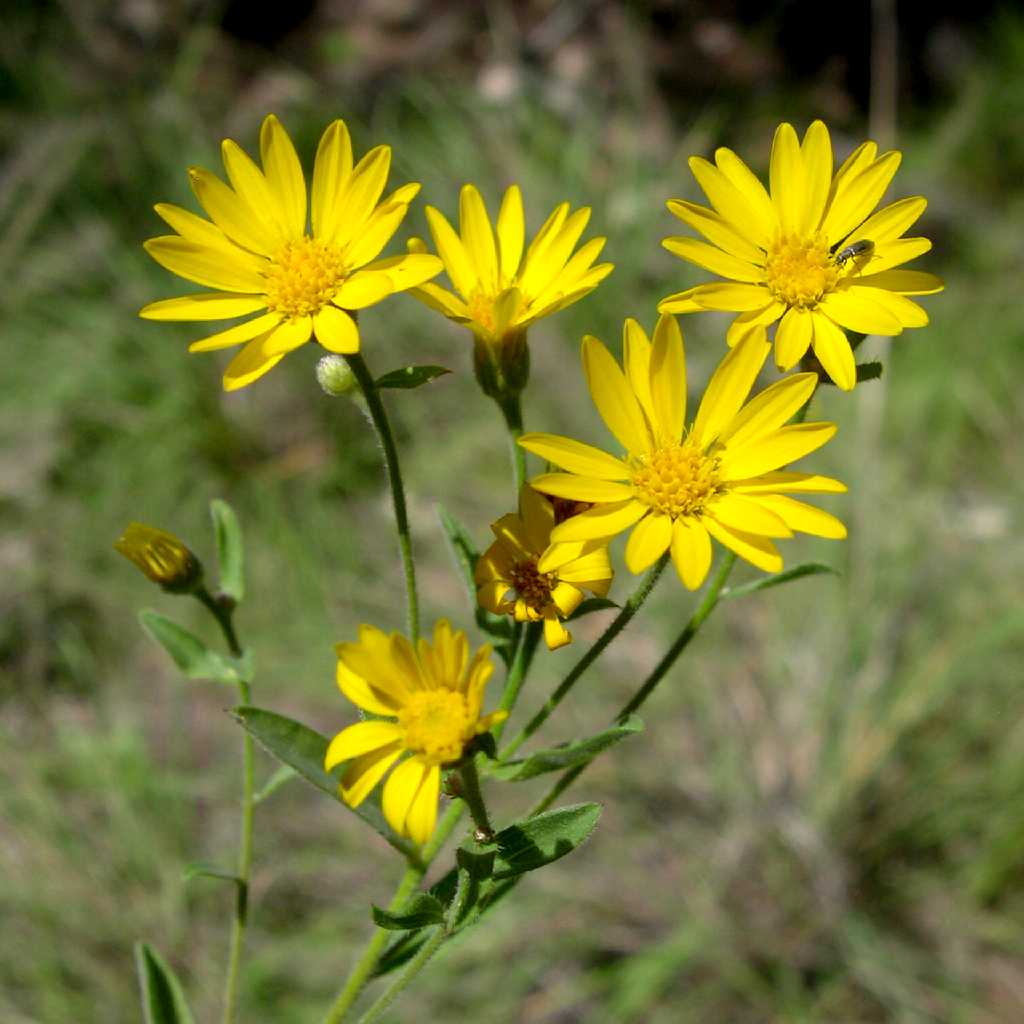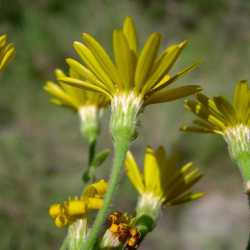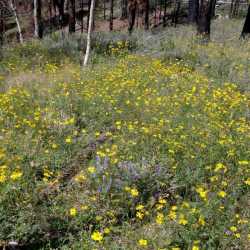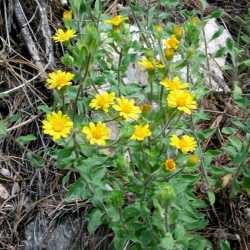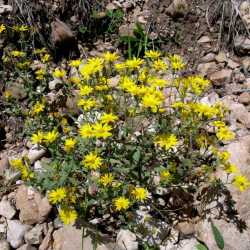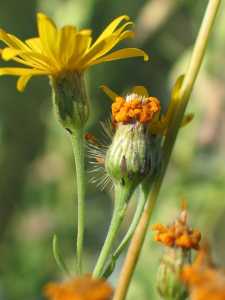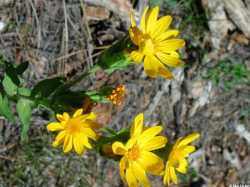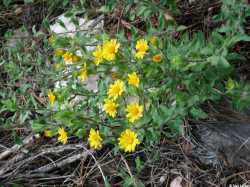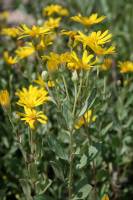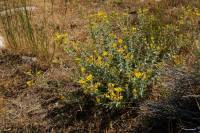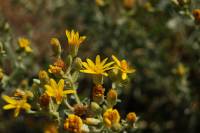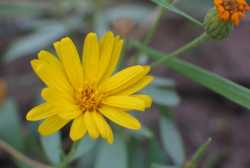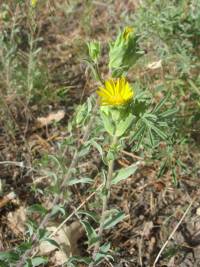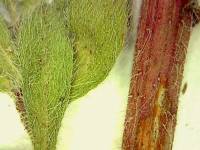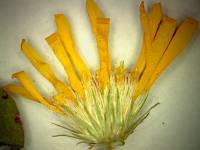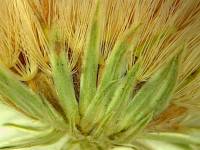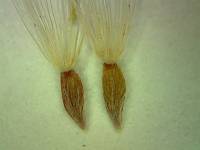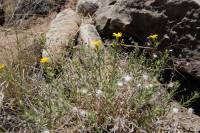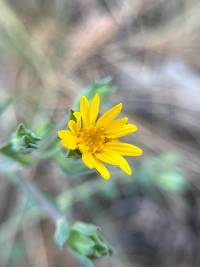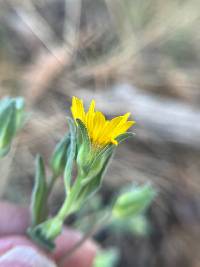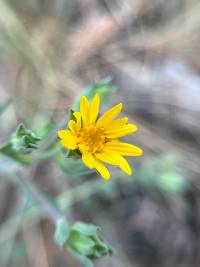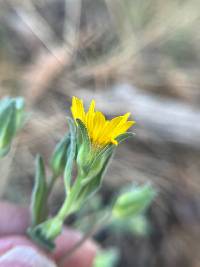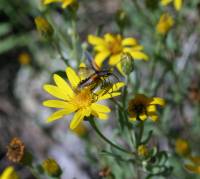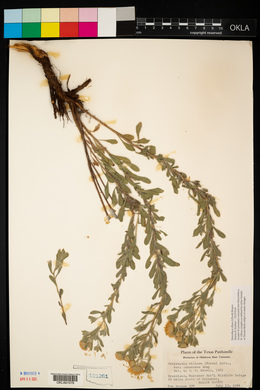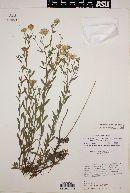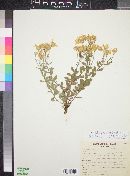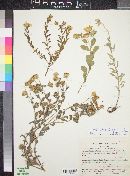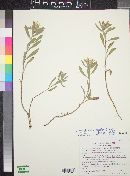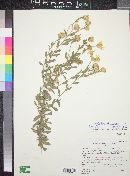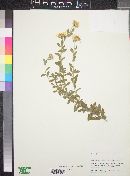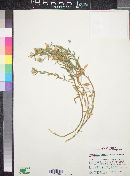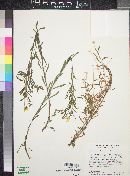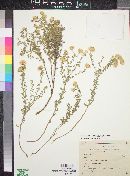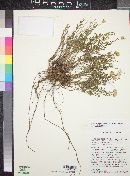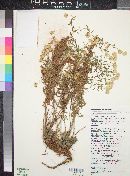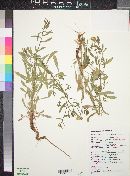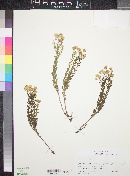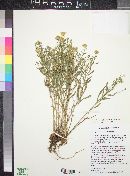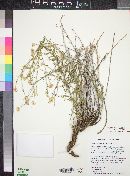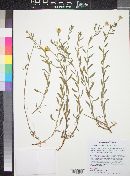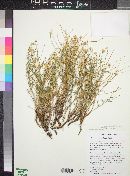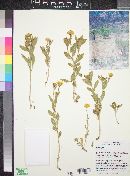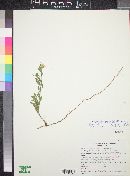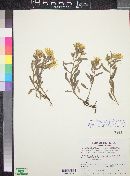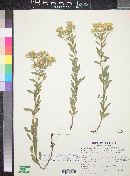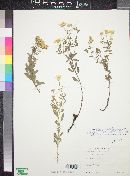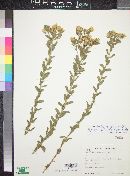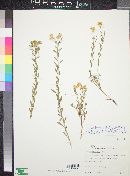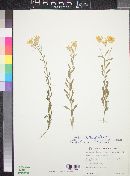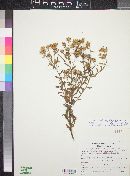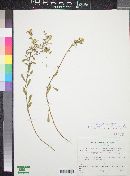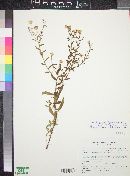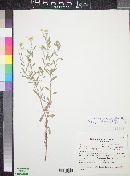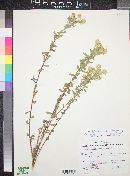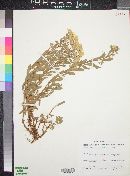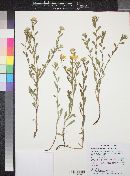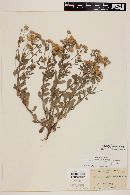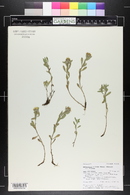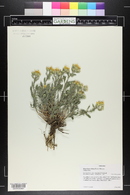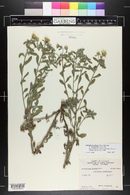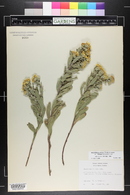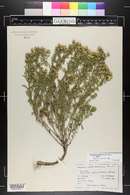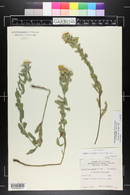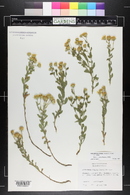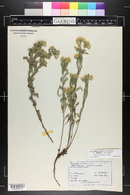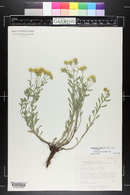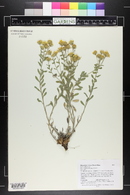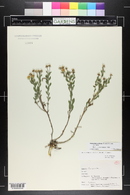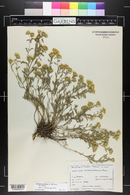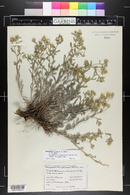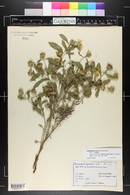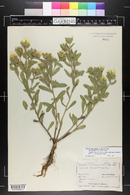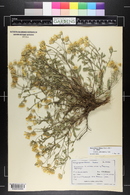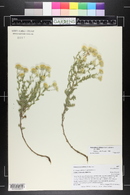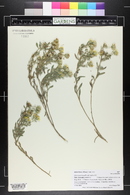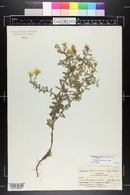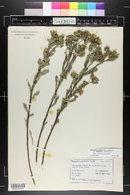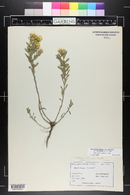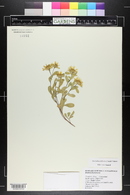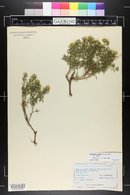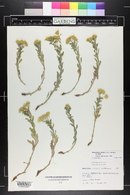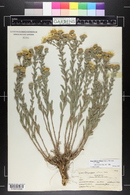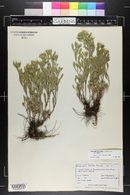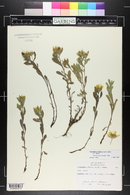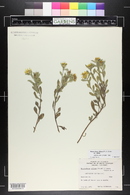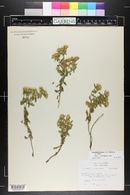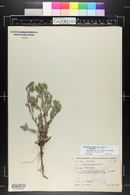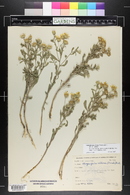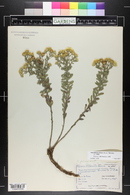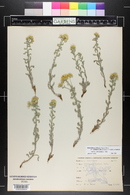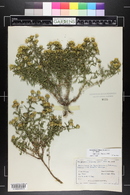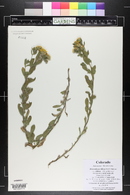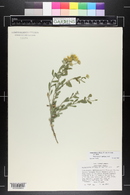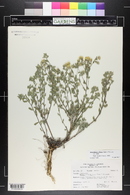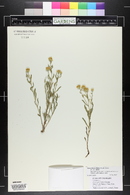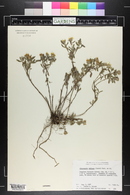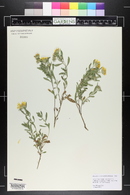Heterotheca villosa
|
|
|
|
Family: Asteraceae
Hairy False Golden-Aster, more...hairy false goldenaster, hairy goldenaster, hairy false goldaster, hairy goldaster
[Amellus villosus Pursh] |
Perennials, (5-)16-40(-70) cm; taprooted. Stems 1-50+, decumbent to erect (sometimes brown or reddish brown, sometimes whitish distally, sometimes ± brittle), sparsely to densely hispido-strigose, sparsely to abundantly long-hispid, eglandular or sparsely to densely stipitate-glandular. Leaves generally not crowded; proximal cauline petiolate, blades oblanceolate, (90-)220-400(-600) × (2-)4-8(-13) mm, bases cuneate, margins flat, usually entire, rarely with 1-2 apical teeth, strigoso-ciliate, sparsely to abundantly long-hispido-strigose proximally, apices acute to obtuse, sometimes mucronate, faces sparsely to densely hispido-strigose, eglandular or sparsely to densely stipitate-glandular; distal sessile, blades usually lanceolate or oblanceolate to oblong, rarely ovate or lanceolate-triangular, (4-)15-28(-42) × (1.5-)3.5-7(-12.5) mm, bases attenuate to convex-cuneate to rounded, margins usually flat, rarely remotely undulate, strigoso-ciliate, sparsely to abundantly long-hispido-strigose proximally, apices acute to obtuse, sometimes mucronate, faces sparsely to densely hispido-strigose, eglandular or sparsely to densely stipitate-glandular. Heads 1-16(-42), in usually open, corymbiform, rarely paniculiform arrays. Peduncles (4-)15-41(-98) mm, sparsely to densely hispido-canescent, eglandular or sparsely to densely stipitate-glandular; bracts 1-7+, usually linear-oblanceolate, rarely leaflike and linear-oblanceolate, usually greatly reduced, margins usually flat, rarely remotely undulate, strigoso-ciliate, sparsely to abundantly long-hispido-strigose proximally, apices acute, sometimes mucronate, faces sparsely to densely hispido-strigose, eglandular or sparsely to densely stipitate-glandular; rarely 1-2 leaflike, oblanceolate bracts subtending heads. Involucres narrowly cylindric to campanulate, (5-)6-9.5(-13) mm. Phyllaries in 4-5 series, lanceolate to linear-lanceolate or triangular-lancelate, unequal (outer 1 / 5 - 1 / 3 length of inner), margins scarious, sometimes reddish purple distally, ciliate distally or apically, faces sparsely to densely strigose, eglandular or sparsely to moderately stipitate-glandular. Ray florets (5-)10-20(-38); laminae (3.5-)6.5-11(-20) × 1-2(-3) mm. Disc florets (10-)20-50(-85); corollas barely ampliate, (4-)5-6(-8) mm, glabrous or glabrate (few, minute hairs), lobes 0.4-0.75(-1) mm, glabrous or glabrate (hairs 0.1-0.35 mm). Cypselae monomorphic, obconic, compressed, 1.7–2.7(–3.4) mm, ribs 4–8(–10) (rarely brownish), faces sparsely to moderately strigose; pappi off-white, outer of linear scales 0.25–1 mm, inner of 30–45 bristle (4–)5–6.5(–8.5) mm, longest weakly clavate (usually equaling or longer than corollas). 2n = 18, 36. Varieties 9 (9 in the flora): w North America.
FNA 2006, Wiggins 1964, Kearney and Peebles 1969, MacDougall 1973, Heil et al 2013 Duration: Perennial Nativity: Native Lifeform: Subshrub General: Perennial herbs, 10-50 cm tall, from a taproot; stems 1-50 per plant, decumbent to erect, brown to reddish brown, sometimes whitish toward tips, strigose or villous and sometimes sparsely glandular. Leaves: Alternate along stems, the leaves are usually well spaced on upper spems and often quite sparse lower stems; lowest leaves taper into petioles and upper leaves have wedge-shaped bases; blades oblanceolate with rounded or pointed tips, 2-4 cm long by 4-8 mm wide, the upper leaves smaller than this; blade margins entire, rarely with 1-2 apical teeth; surfaces densely strigose, appearing silvery or grayish. Flowers: Flower heads yellow and radiate, solitary or several near the ends of branches, on hairy peduncles 1-4 cm long; involucres cylindric to campanulate, 7-10 mm high, the bracts (phyllaries) in several slightly graduated series, linear-oblanceolate with pointed tips, green with light colored margins, the green and white parts of the phyllaries sparsely to densely hispido-strigose; ray florets 10-20 per flower head, yellow, the laminae (ray petals) 6-11 mm long; disc florets 20-50 per flower head, yellow. Fruits: Achenes about 3 mm long, obconic, compressed, densely strigose; topped with a pappus of capillary bristles. Ecology: Found on dry slopes, mesas, plains, and openings in a variety of plant communities, from 1,500-8,500 ft (457-2591 m); flowers May-October. Distribution: Western and midwestern US from MN to WA and south to CA, AZ, NM, TX and OK; north to adjacent s CAN provinces. Notes: H. villosa is a quite variable species, and numerous varieties have been recognized but have not been consistently considered valid. Leaf shape and size, as well as growth form and stature vary among populations. Distinguish it from other yellow composites from its grayish hairy leaves, its slightly woody base, and its camphor-like scent when a leaf is crushed between the fingers. Oddly the scent is not mentioned in any treatment I can find, so perhaps it is not universal; however in my experience (in Arizona and the Four Corners region) this is a diagnostic character, though not unique to this species within Heterotheca (for example, the common name for H. axillaris is camphorweed). Ethnobotany: Used for ant bites, for toothache, as a disinfectant, a sedative, for chest pain, ceremonially, an emetic, for indigestion, as a heart medicine, and as a treatment for venereal disease. Etymology: Heterotheca is from Greek heteros, different, and theke, ovary, referring to the dimorphic achenes of some members in the genus; villosa means hairy. Synonyms: Chrysopsis villosa Editor: SBuckley 2010, AHazelton 2017 From Flora of Indiana (1940) by Charles C. Deam Locally common in very sandy soil along roadsides in the counties indicated on the map. This species is easily cultivated and is worthy of cultivation, but, no doubt, it would soon spread if a congenial habitat were nearby unless the seed were collected before they became mature. |
|
|
|

